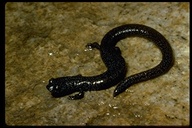|
Description
Salamanders of the genus Batrachoseps are generally small and elongated, have short limbs, and are fossorial. B. major has an especially enlongated and wormlike body, four toes on the hind feet, and 17 to 20 costal groves. Adults reach 50 mm standard length. The head is flat and oval in dorsal profile and widest at the jaw, which is equal or slightly greater than the width of the body. The snout is obliquely truncate in lateral profile. The eyes are large, elliptical, and protruding. A well-defined middorsal furrow runs the length of the body and tail. Their 17 to 20 costal groves weakly encircle the body ventrally. The coloration varies greatly between and within populations, but their bodies are generally dark on the dorsum with dark iridophores in arranged in a netlike pattern. Brassy and pale blue iridophores on the dorsum form a dorsolateral stripe that is more noticeable on some specimens than others. The sides have a light bluish tint because of ventral speckling. Dark coloration extends midway down the ventral region which contains blue and white iridophore speckling. The mental, gular, pectoral, and pelvic regions contain dark iridophores. The iris of the eyes is black with brassy iridophores, and coppery iridophores are present on the tops of the eyes and snout. Distribution and Habitat
Country distribution from AmphibiaWeb's database: Mexico, United States U.S. state distribution from AmphibiaWeb's database: California
This species ranges into northwestern cismontane and montane Baja California. Its range extends from Los Angeles county south to the northwestern Baja peninsula, ending in the region of Arroyo Grande, approximately 24 km southeast of the El Rosario vicinity. It can also be found on the Pacific islands Coronado Norte, Media, and Sur, Todos Santos Sur, and perhaps San Martín, and at elevations up to 1785 m (Grismer 2002). It resides in dense chapparal, foothill forests, and riperian corridors within the California region, but also occurs in locally moist areas in the southern arid regions, and in riperian and meadow habitats in the Sierra San Pedro Mártir. It usually is found beneath rocks, logs, large leaves, and other surface litter. It was also reportedly found in the Vizcaíno Region beneath decaying Desert Agave (Grismer 2002). It also lives in rural gardens, urban areas, and trash (IUCN). Substrate temperatures for other Batrachoseps species are within the range of 5.2–25.0 C, and similar temperatures are preffered by most members of this genus (Wake et. Al 2002). Life History, Abundance, Activity, and Special Behaviors
B. major is a nocturnal species that is active above ground during the rains from fall to spring, and remains below ground during the drier months. It does not create its own burrows but rather uses those of other animals or cracks in the soil to go underground. Its reproductive season has been observed to be early to late spring. Coiling the body when held is a common defensive behavior among Batrachoseps (Wake et al. 2002). [3608] Trends and Threats
It is common within its range, and its numbers are estimated to exceed 10,000 individuals. Comments
See other subspecies accounts at www.californiaherps.com: B. m. aridus and B. m. major. IUCN, Conservation International, and NatureServe. 2004. Global Amphibian Assessment. . Accessed on 11 March 2005.
References
Grismer, L. L. (2002). Amphibians and Reptiles of Baja California. University of California Press, Berkeley.
Wake, D. B., Yanev, K. P., and Hansen, R. W. (2002). ''New species of slender salamander, genus Batrachoseps, from the Southern Sierra Nevada of California.'' Copeia, 2002(4), 1016–1028.
Originally submitted by: Shelly Lyser (first posted 2005-06-20)
Edited by: Tate Tunstall (2005-08-18)Species Account Citation: AmphibiaWeb 2005 Batrachoseps major: Garden Slender Salamander <https://amphibiaweb.org/species/5340> University of California, Berkeley, CA, USA. Accessed May 13, 2025.
Feedback or comments about this page.
Citation: AmphibiaWeb. 2025. <https://amphibiaweb.org> University of California, Berkeley, CA, USA. Accessed 13 May 2025.
AmphibiaWeb's policy on data use.
|




 Raffaëlli Account
Raffaëlli Account Map of Life
Map of Life